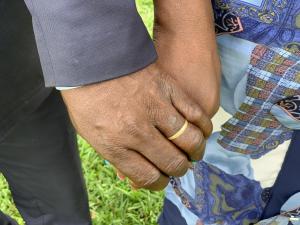Learning to live as a couple when one partner is HIV-positive in Sierra Leone
“The greatest support I ever received living with HIV for 10 years has come from my HIV-negative partner.”
Jane* was pregnant when she discovered she was HIV-positive in 2008. She remembers feeling devastated. “I became utterly preoccupied with thoughts about my condition, about which I knew next to nothing other than the various myths and misconceptions and stigma around the disease,” she says.
Stigma in particular was her greatest fear. “Fortunately for me, the greatest support I ever received living with HIV for 10 years has come from my HIV-negative partner—the most courageous person I have ever known,” she smiles.
Jane was 21 and still a college student when she became pregnant. She and her boyfriend, John*, then 26, were happy with the news. “John and I celebrated the pregnancy, planned for the best care and a good life for our child. So, I got the best support a man could give his pregnant partner. In fact, we were pregnant together because he seemed to know more about pregnancy at the time than me,” Jane recalls.
The young couple was determined to safeguard the health of the pregnancy, for the mother and the child. They wasted no time making their first antenatal visit to a maternity clinic in Freetown.
It was then Jane learned she was HIV-positive. John tested negative for the disease, although he held off telling Jane for fear the situation would cause too much stress and affect the young pregnancy.
Staying together, reducing the risks
“It is possible for one partner to be HIV-positive while the other is not and that is what is referred to as a ‘serodiscordant couple’,” says Dr Oluyemisi Akinwande, HIV Specialist at the World Health Organization (WHO) Sierra Leone Country Office.
According to WHO, up to 50% of HIV-positive people in ongoing relationships globally have HIV-negative partners. In Sierra Leone, as the 2013 Demographic Health Survey findings indicate, 2.6% of cohabiting couples are serodiscordant.
“It is also possible for serodiscordant couples to have children who are HIV-negative. To maximize the likelihood of giving birth to a HIV-negative child among serodiscordant couples, the HIV-positive partner should be on an effective antiretroviral drug combination and with suppressed viral load,” Dr Akinwande stresses.
But what happens in many situations due to fear the partner may leave, an HIV-positive individual does not disclose their status to their partner. And many do not know their partner’s status. The lack of disclosure increases the risk between partners and can lead to a significant number of new HIV infections among serodicordant couples.
Jane and John are an ideal example of how honesty in a relationship leads to diminished risk and the fulfilment of traditional expectations as a couple, including marriage and giving birth.
When John disclosed his HIV-negative status to Jane, her reaction was mixed. She recalls feeling happy for him but that the happiness was short-lived. She felt insecure and worried John would leave her. “But I was completely wrong,” she beams.
Making counselling and treatments free In addition to the medication regimen Jane was put on to keep her viral load low and to the protections the couple embraced to keep John virus-free, the couple welcomed the counselling available through the government’s HIV response programme.
The Global Fund to Fight AIDS, Tuberculosis and Malaria, UNAIDS, WHO, and other partners are helping the Sierra Leone Ministry of Health and Sanitation to provide appropriate free and confidential HIV counselling and testing services in more than 60% of public health facilities in the country. The counselling includes a component for couples like Jane and John.
Jane and John indicate that counselling helped them through the sometimes rocky initial years together, when they were learning to live with HIV and with bitter disappointments. As John had feared, Jane miscarried shortly after learning about her HIV status.
A few years after the miscarriage, the couple married. “I wept for joy on my wedding day, and only John and I knew why,” says Jane.
Then, after nearly eight years of trying to conceive again, Jane became pregnant. With the right care, the child was born free of HIV through the aggressive but standard Prevention of Mother-to-Child Transmission of HIV, or PMTCT, programme.
Managed by the Sierra Leone Ministry of Health and Sanitation at health facilities across the country, the PMTCT programme ensures that antiretroviral treatment is administered as early as possible to pregnant women who are living with HIV to prevent the transmission of the virus to their child.
Sierra Leone is one of 16 countries in West and Central Africa where WHO is working intensely to improve the HIV response. Countries in the region are lagging in their HIV treatment coverage, with 40% of all people living with HIV accessing treatment, compared with 54% in East and Southern Africa countries.
Sierra Leone is implementing the WHO Treat All policy, in which everyone who tests positive for HIV is offered antiretroviral treatment for free.
How good things are possible
“Good things will always happen to you if you respond positively to your situations and circumstances. So, the birth of our child is our miracle because we stayed focused, even in what seemed the worst moment of our lives,” Jane reflects.
After a decade together, Jane and John have strengthened their relationship. John remains HIV-negative and committed to giving his wife the best support.
“We have a healthy child and a completely normal relationship. We both have an alarm clock on our phones as a reminder to take my medication, and he is fully involved in my treatment. John is a special kind of person I have been blessed with. Our daughter is our new source of happiness.”
* Jane and John are pseudonyms to protect their identities.



